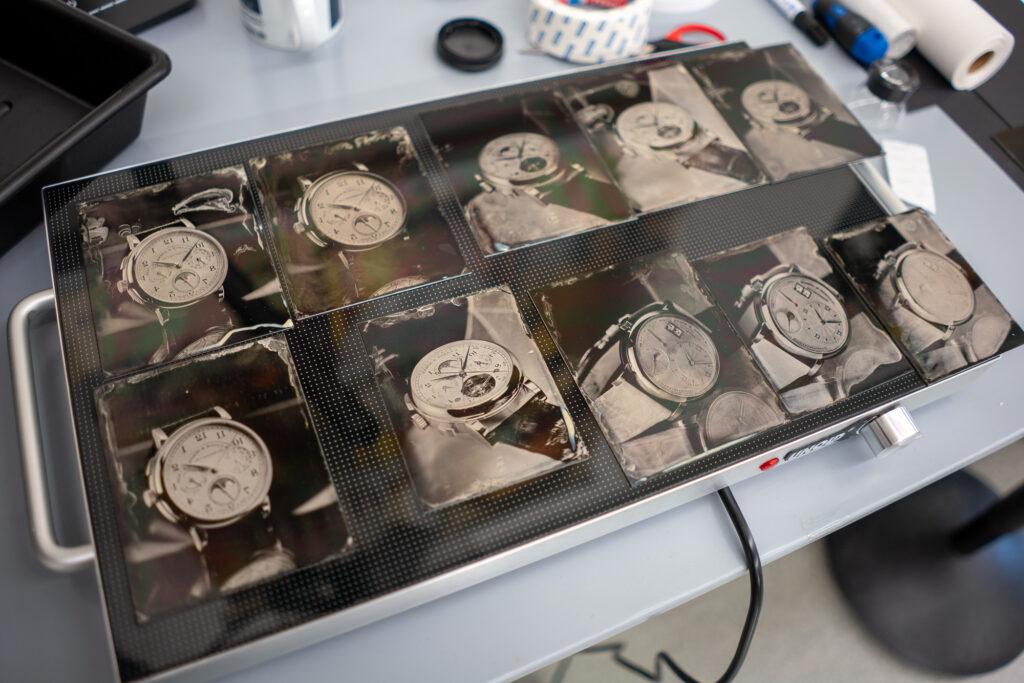Wet Plate Photography
Wet Plate Photography
A. Lange & Sohne contacted me for an exclusive behind the scenes event. Capturing some of their watches in a very special way using wet plate photography. We all know that photoghraphy is important for presenting watches in the best way possible but sometimes you don’t want those picture perfect images. Where the average packshgot oir soldier images looks amazing it misses that real life feeling. Se when it comes to sharing images it’s great to see some more authentic shots. But when you look at the watchmaking tradition and craftsmanship you realise that back in the days photography was a different trade.
Being a photographer myself I have learned the trick of the trade the hard way. Spending endless hours developing my skills a and techniques through the years. Yet it’s far from the original way images were captured back in the days. There were no previews on a screen that gave you an idea of what the image would look like. However it still exists today and it was pretty exciting to receive an invite to capture the traditional photoshoot. So I am about to learn how photos are made the old fashion way using plates, chemicals and endless patience.
Delicate and timely process
Upon arrival in an industrial area I found myself in a large photo studio. Here the team had their equipment all set up which they used the day before already. After a short introduction we looked at the process and and the steps we had to capture which are about 10 in total. So for the day we would go through them several times and I quickly learned that it’s a delicate and time consuming process.

Like with all photography the setup of the lights and camera is equal. Finding the right composition is similar to the way I do it. However setting up a bellow camera asks for a lot more adjustments. With it’s multiple anchor points is functions as a tilt & shift lens which allows you to correct the perspective. In modern photography there are special lenses available for this which are mostly used in architecture. So after some time adjusting lights and the camera we are good to go.

Lightproof ‘igloo’
This is where it get’s a bit more complicated. After setting up the image we need something to record it. This is where it get’s interesting as we enter the lightproof igloo which is setup in the studio. All possible light openings are taped shut to prevent light coming in.

Inside there is just a bit of red led light which is just enough to see what you are doing. We start with a brand new sheet of aluminium of about 4×5” which only needs the protective film removed. To be able to capture an image on it we need to add a film of collodium by hand. Any excess liquid is removed and the plate now goes into a silver oxide liquid which sticks to the collodium. After some minutes the plate is ready and transferred into a plate holder.
Behind the scenes of a wet plate photography photoshoot.

With the plate holder installed into the camera it’s time to do the actual capture. Unlike modern camera’s this takes up to several minutes. Even with a lot of light it takes a long time to record the image. So when the shutter is opened the capture begins which is timed with the help of a stopwatch. After the desired exposure time the shutter is closed again pressing the cable release. Next, the plate holder is closed so it can be transferred to the darkroom where the image is further developed. Once taken out of the plate holder, a development liquid is poured over which reveals the image already yet in a negative way. During the next steps the image is rinsed several times during which you can see the image transform into a clear picture.

One day to create 12 images
It takes a full day of work to create about 12 photos. This gives you an idea about the amount of time and work that goes into creating these photos the traditional way. The results are pretty amazing and each photo has it’s tiny flaws which gives it that extra touch. We also had our portraits taken which turned out pretty amazing.

 Previous post
10 golden tips for watch photography
Previous post
10 golden tips for watch photography
